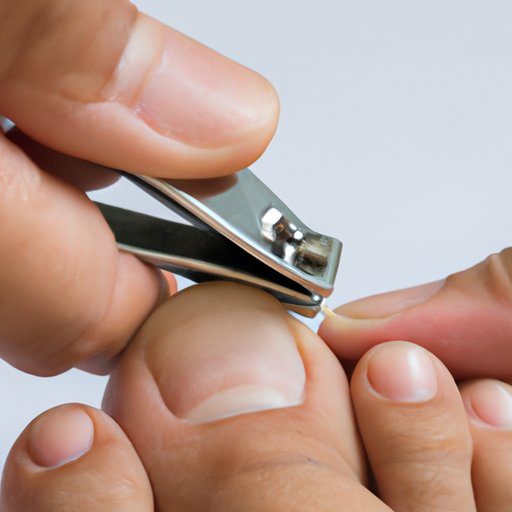
Introduction
Ingrown toenails are a common and painful condition that can be caused by tight footwear, improper nail trimming, or even genetics. If left untreated, they can lead to infections and more severe complications. In this article, we will provide you with a comprehensive guide on how to cut an ingrown toenail safely, prevention tips, and debunk common misconceptions about toenail cutting.
Step-by-Step Guide to Cutting an Ingrown Toenail Safely
To cut an ingrown toenail safely, you will need first to soften the affected toenail by soaking it in warm water. Gently lift the nail edge with a pair of tweezers and cut the nail straight across using a nail clipper. Avoid cutting the nail too short or rounding the edges. If you experience any pain or bleeding, stop immediately and seek medical advice.
How to Prevent Ingrown Toenails
Preventative measures are essential in avoiding ingrown toenails. This includes wearing properly fitting shoes, trimming your nails regularly, and maintaining good hygiene. When cutting your toenails, avoid curving the corners and instead cut them straight across.
Myth vs. Fact: Debunking Common Misconceptions about Cutting Ingrown Toenails
One popular myth is that cutting a V-shape on the toenail will aid in healing an ingrown toenail. However, this method can make the condition worse and lead to infection. Instead, cut the nail straight across and allow it to grow naturally outwards.
What Not to Do When Cutting an Ingrown Toenail
When cutting an ingrown toenail, avoid using pointed or sharp objects such as scissors or knives, as they may cause further damage to the skin. Also, do not try to dig the nail out or remove any surrounding tissue. It may lead to infection and make the condition worse.
Comparing Different Techniques for Cutting Ingrown Toenails
There are various cutting tools and techniques used to remove an ingrown toenail, which include DIY home remedies, surgery, and the use of specialized toenail clippers. Each method has its benefits and drawbacks. It is best to seek advice from a medical professional to determine which method is suitable for you
Dealing with Complications of an Ingrown Toenail
If an ingrown toenail becomes infected, it can cause redness, swelling, and pus to form. To prevent worsening the condition, avoid wearing tight shoes and keep the affected area clean and dry. Seek medical attention if the pain or swelling persists or you develop a fever.
Conclusion
Ingrown toenails can be a painful and uncomfortable condition to deal with, but with proper care and attention, they can be easily managed. Remember to follow the correct cutting techniques, maintain proper hygiene, and seek medical attention if necessary. We hope this comprehensive guide has provided you with the necessary information to confidently tackle ingrown toenails.




